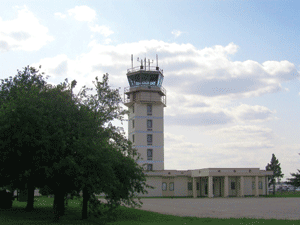One other reason for this directional shift could be the presence of what MoDOT calls, again tellingly, "the Richards-Gebaur intermodal facility." In fact, the old Richards-Gebaur air base has been closed for a generation. This new 1400-acre facility actually does have a name of its own, the "Intermodal Freight Gateway," which, truth be told, it has done a poor job of branding. That will change too.
Further south, in the Belton area, construction is underway to widen Highway 58 to four lanes from Holmes Road to the Kansas City Southern Railway, and to three lanes with four roundabout intersections from Prospect Avenue to Scott Avenue.

Redevelopment of the former Richards-Gebaur Memorial Airport into the 1400-acre "Intermodal Freight Gateway" is expected to cost more than $500 million.
Ironically, the nightmare of the Grandview Triangle may actually have helped Lee's Summit boom the way it has. The critical ingredient in Lee's Summit's growth of course is I-470, which heads east to the outskirts of the older part of town before heading north and hooking up with I-70. Until the interstate came through, Lee's Summit had depended on the slow and frustrating U.S. Highway 50 for its connection to Kansas City. Now, a ramped up 50 intersects with I-470, and a community has exploded around it.
The irony comes from the fact that Lee's Summit is further from Kansas City than Grandview. It is also more developed than the area to the west of it, which is also closer to Kansas City. Still, if its residents want to go into the city or to head up north or even to travel east, they have more options than the Grandview residents. They can take U.S. Highway 50 or Missouri Highway 291 or head up I-470 to I-70. The development of the Triangle will make life still easier for Lee's Summit's residents while it fills up the western parts of the city back towards Grandview.
Back East To the east and north, when I-470 crossed I-70 and hooked up with an improved Missouri Highway 291, the center of gravity in Independence shifted dramatically to this new and vital crossroads. With the addition of the Bass Pro complex and a new HCA hospital nearby, Independence faces a similar question to the one that Downtown Kansas City faces. Can the infrastructure handle the traffic?
People who travel this route certainly hope so. The highway-widening project on I-70 has shown them what a real traffic snarl can look like. But when this project wraps up and the new construction on nearby Jackson Drive and Little Blue Parkway is complete, this new and improved crossroads will hold a world of potential.
The grandfather of all area Interstate crossroads is the intersection of I-70 and I-435 east of Downtown Kansas City. In the late 1960s city leaders saw the potential of this then new site, and they exploited it by building the Truman Sports Complex, the first twin stadium project in America.
What has not happened, at least not to the degree that planners might have hoped, is the emergence of a vital and spontaneous commercial base around the ballparks. The reason for this is pretty obvious. The ballparks do not require any external commerce. They are sufficient unto themselves.
By building generous parking lots with multiple points of access, planners created what may be America's most fan-friendly ballparks. The fact that Kansas City has developed a superior tailgating culture has much more to do with the ample parking than with the town's renowned barbecue. You can't fire up the old grill inside a parking garage or on the front lawn of some opportunistic ballpark neighbor.

The Truman Sports Complex, at the crossroads of I-70 and I-435, was the first twin stadium project in America, and is possibly the most fan-friendly ballpark in the country.
The crossroads location enables the parks to receive a balanced stream of traffic from all four directions, more perhaps from the west and the south but even that is changing as the Northland and the south and east sections of the metro develop. Anyone planning to relocate these parks would have to address all of the aforementioned variables.
Into the city Easily the cleverest billboard in the late, unlamented political season was the one by the Jeanne Patterson campaign at the Gregory Boulevard stoplight on U.S. Highway 71. If elected, Patterson promised to get rid of it. All campaign promises aside, the removal of these lights seems like an inevitability. U.S. Highway 71 will not deliver on its extraordinary promise for the city of Kansas City until the traffic slogging stoplights are history.
Even with them, however, U.S. Highway 71 has opened up the city in unexpected ways. The Plaza has been a prime beneficiary as it pushes eastwards towards the intersection of U.S. Highway 71 and the parkways on either side of Brush Creek, an inter-section of glittering potential. U.S. Highway 71 has also helped open up Downtown Kansas City and generate its renewal as well as the largely unseen revival on the far east side of downtown along streets like Troost and Gillham.
